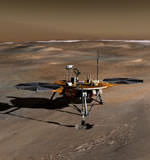
Image credit: NASA/JPL
NASA announced on Monday that it has selected the University of Arizona’s “Phoenix” mission to launch to Mars in 2007 as part of its new, low-cost Scout mission. NASA has granted the university $325 million to build the spacecraft, which will land on the planet’s northern pole, which is rich in water ice. The mission will have two goals: to study the geologic history of water, and to search for evidence of a habitable zone that may exist in the ice-soil boundary.
In May 2008, the progeny of two promising U.S. missions to Mars will deploy a lander to the water-ice-rich northern polar region, dig with a robotic arm into arctic terrain for clues on the history of water, and search for environments suitable for microbes.
NASA today announced that it has selected the University of Arizona “Phoenix” mission for launch in 2007 as what is hoped will be the first in a new line of smaller competed “Scout” missions in the agency’s Mars Exploration Program.
Dr. Peter H. Smith of the University of Arizona Lunar and Planetary Laboratory heads the Phoenix mission, named for the mythological bird that is repeatedly reborn of ashes. The $325 million NASA award is more than six times larger than any other single research grant in University of Arizona history.
“The selection of Phoenix completes almost two years of intense competition with other institutions,” Smith said. “I am overjoyed that we can now begin the real work that will lead to a successful mission to Mars.”
Phoenix is a partnership of universities, NASA centers, and the aerospace industry. The science instruments and operations will be a University of Arizona responsibility. NASA’s Jet Propulsion Laboratory in Pasadena, Calif., will manage the project and provide mission design. Lockheed Martin Space Systems, Denver, will build and test the spacecraft. Canadian partners will provide the meteorological instrumentation, including an innovative laser-based sensor.
Phoenix has the scientific capability “to change our thinking about the origins of life on other worlds,” Smith said. “Even though the northern plains are thought to be too cold now for water to exist as a liquid, periodic variations in the martian orbit allow a warmer climate to develop every 50,000 years. During these periods the ice can melt, dormant organisms could come back to life, (if there are indeed any), and evolution can proceed. Our mission will verify whether the northern plains are indeed a last viable habitat on Mars.”
The lander for Phoenix was built and was being tested to fly as part of the 2001 Mars Surveyor Program, but the program was canceled after the Mars Polar Lander was lost upon landing near Mars’ south pole in December 1999. Since then, the 2001 lander has been stored in a clean room at Lockheed Martin in Denver, managed by NASA’s new Mars Exploration Program as a flight asset.
Renamed Phoenix, it will carry improved versions of University of Arizona panoramic cameras and volatiles-analysis instrument from the ill-fated Mars Polar Lander, as well as experiments that had been built for the 2001 Mars Surveyor Program, including a JPL trench-digging robot arm and a chemistry-microscopy instrument. The science payload also includes a descent imager and a suite of meteorological instruments.
The mission has two goals. One is to study the geologic history of water, the key to unlocking the story of past climate change. Two is to search for evidence of a habitable zone that may exist in the ice-soil boundary, the “biological paydirt.”
The Phoenix robotic arm will scoop up martian soil samples and deliver them for heating into tiny ovens of the volatiles-analysis instrument so team members can measure how much water vapor and carbon dioxide gas are given off, how much water ice the samples contain, and what minerals are present that may have formed during a wetter, warmer past climate. The instrument, called thermal evolved gas analyzer, will also measure any organic volatiles.
Using another instrument, researchers will examine soil particles as small as 16 microns across. They will measure electrical and thermal conductivity of soil particles using a probe on the robotic arm scoop. One of the most interesting experiments is the wet chemistry laboratory, Smith said.
“We plan to scoop up some soil, put it in a cell, add water, shake it up, and measure the impurities dissolved in the water that have leached out from the soil. This is important, because if the soil ever gets wet, we’ll know if microbes could survive. We’ll know if the wet soil is super acidic or alkaline and salty, or full of oxidants that can destroy life. We’ll test the environment that microbes might have had to live and grow in,” Smith said.
Information is available online about NASA’s Mars exploration at http://mars.jpl.nasa.gov and about Phoenix at http://phoenix.lpl.arizona.edu .
Original Source: NASA News Release
